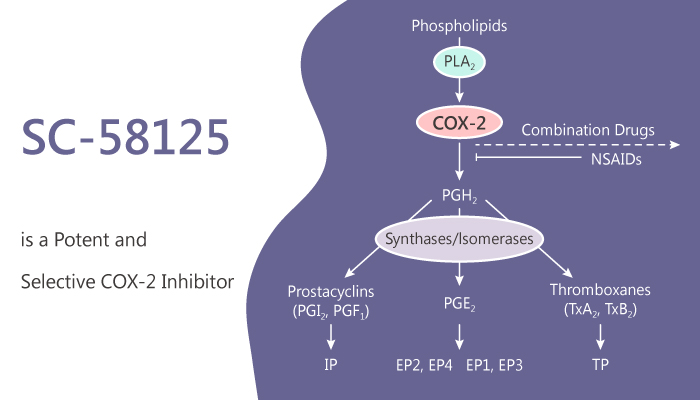Nonsteroidal anti-inflammatory agents (NSAIDs) are useful for the treatment of inflammatory diseases. In particular, NSAIDs inhibit the enzyme cyclooxygenase (COX), which catalyzes the conversion of arachidonic acid to prostaglandins (PGs) and thromboxane. COX-1 constitutively expresses in most tissues and organs, and the inducible enzyme, COX-2 localizes primarily to inflammatory cells and tissues. Selective inhibition of COX-2 may produce superior anti-inflammatory agents with substantial safety advantages over existing NSAIDs.

SC-58125 potently and selectively inhibits COX-2 (IC50=0.05 μM). Moreover, SC-58125 inhibits the growth of both HCA-7 and LLC cells grown in culture by delaying transit through the G2 phase of the cell cycle. SC-58125 completely suppresses pouch prostaglandin synthesis (ED50=0.1 mg/kg). Furthermore, short-term (48 hours) treatment with SC-58125 is sufficient to attenuate tumor growth for up to 15 days.
SC-58125 effectively inhibits the growth of established tumors and primarily exerts a cytostatic effect in vivo. Treatment with SC-58125 blocks the growth of carcinoma cells by causing a delay in the transition through the G2/M phase of the cell cycle with a reduction in p34cdc2 levels. Therefore, SC-58125 effectively inhibits prostaglandin synthesis in the xenografted carcinomas, indicating that SC-58125 is well distributed to the tumor site. Hypothetically, SC-58125 treatment causes a reduction in tumor size by decreasing proliferation and/or increasing apoptosis rates within the tumor. Besides, SC-58125 treatment inhibits the growth of established tumors. Treatment with SC-58125 inhibits the growth of colorectal cancer xenografts. In addition, SC-58125 reduces the growth of established colon carcinoma xenografts, resulting in tumor cytostasis.
All in all, SC-58125 is a selective inhibitor and inhibits edema at the inflammatory site and is analgesic.